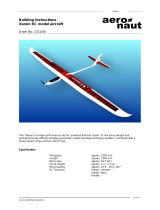
16
linkage use one of the pre-formed aileron pushrods 46 (1 Ø
x 80 mm); for the rudder use the pre-formed rudder pushrod
47 (1 Ø x 110 mm).
Check that the servos and control surfaces are set
accurately to “neutral”, then tighten the allen-head
grubscrews in the swivel pushrod connector barrels.
Figs. 19 + 20
12. Installing the battery bearer plate
The battery bearer plate 40 should be glued in the front part
of the fuselage under the canopy, using either hot-melt glue
or cyano with activator. The retaining strap for the flight
battery 41 should be fitted under the battery bearer plate,
and you will find it easier to install this before the plate is
glued in place.
Fig. 21
13. Completing the wing
Cut through the depressed area at both ends of the ailerons
to allow them to move up and down. Free up the hinge
lines by moving the control surfaces to and fro, but take
care not to stress them by deflecting them too far (maximum
45°). Don’t separate the control surfaces!
14. Installing the main spar and spar caps
During the next stage it is important to keep the wing resting
flat on the building board; it must not be under stress. When
you are working on the underside of the wing, pack it up
carefully so that it does not distort.
The first step is to glue the rectangular-section CFRP spar
50 in the channel in the underside of the wing using cyano.
When you have done this, glue the GRP spar caps 52 in
the channels directly over the CFRP spar and extending
towards the wingtips, and in the other channels in the top
and bottom of the wing, again using cyano. Use protective
gloves for this procedure, otherwise it is highly likely that
your fingers will become stuck to the wing as excess glue
is forced out of the channels.
This is the procedure: apply cyano along the channel, place
the spar cap at the start of the slot, and gradually press it
into place, working along the wing. Just before you reach
the end of the channel, snip off the excess length using a
pair of side-cutters. Apply more cyano and wipe it along
the spar channels, so that the slots and spar caps are
reasonably well sealed, giving a flush surface to the wing.
At this point you can spray activator over the area in order
to accelerate the cure. Hold the nozzle some distance away,
otherwise the propellant could blow the adhesive out of the
channels.
Figs. 22, 23, 24
15. Installing the screw bushes
Glue the plastic screw bushes 35 in the underside of the
wing centre section.
Fig. 25
16. Preparing and installing the aileron horns
Fit the spigots of the articulated barrels 29 into the holes in
the “Twin” aileron horns 28. Check that the barrels rotate
smoothly; you may need to remove any sharp edges. Fit
the socket-head grubscrews 30 in the connector barrels
29 using the allen key 31.
Glue the horns in the moulded-in recesses in the ailerons,
as described for the elevator and rudder.
Fig. 26
17. Installing the aileron servos
Set the aileron servos to neutral (centre) from the
transmitter, then fit the output arms on them in such a way
that the arms project at 90° to one side of the case - 1 x left
and 1 x right (mirror-image pair).
Check that the servos are a snug sliding fit in the moulded-
in recesses in the wing panel 7; Note that the output shaft
of both servos should be towards the wing leading edge.
Depending on the type of servo you are using, you may
find that minor trimming is required to the servo recesses.
The servos can be secured with a drop of hot-melt glue or
cyano applied to the slots in the wings which accommodate
the servo mounting lugs: press the servos into the recesses
immediately after applying the glue, and apply another drop
of adhesive to each mounting lug if required for security.
Fig. 26
18. Connecting the aileron pushrods
The servo output arms are connected to the aileron horns
using the pre-formed steel pushrods 45 (1 Ø x 70 mm).
“Wiggle” the “Z”-end of the pushrod through the hole in the
servo output arm (warming the wire will help), then slip the
straight end through the barrel of the articulated pushrod
connector. The aileron pushrods should be connected to
the second hole from the outside of the servo output arms.
Check that the servos and ailerons are set accurately to
“neutral”, then tighten the allen-head grubscrews in the
articulated connector barrels.
Figs. 27
19. Installing the pushrod fairings
Glue the pushrod fairings 43 and 44 in the appropriate slots.
Be sparing with the glue, so that you can easily gain access
to the servos should they require replacement.
Fig. 28
20. Attaching the wing
Before attaching the wing 7 to the fuselage, connect the
aileron servo extension leads and route them through the
opening into the radio compartment. The wing is attached
to the fuselage using the two plastic M5 x 35 mm screws
32.
Fig. 29
21. Installing the motor
Fix the motor 61 to the firewall 36 using the screws 65 and
washers 66.
Connect the speed controller 62 to the motor wires, and
check that it rotates in the correct direction. If you find that
the motor spins the wrong way round, simply swap over
any two of the cables between the motor and the speed
controller.
Fig. 30
If you set all four adjuster screws 38 to project by 2 mm,











